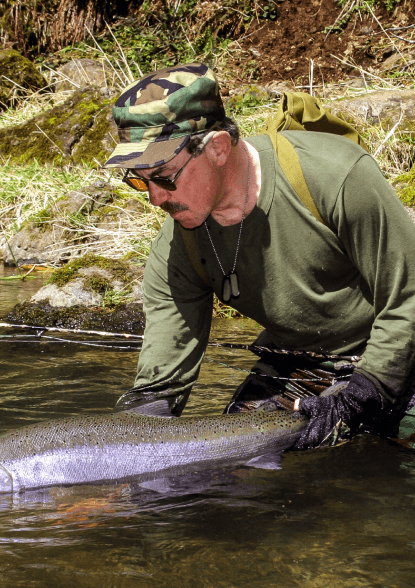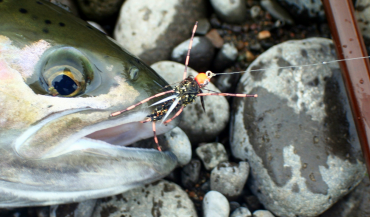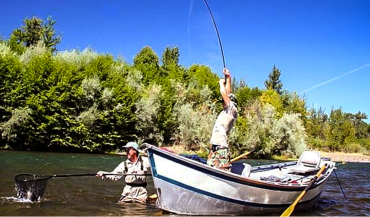There are three general fly fishing methods, which correspond to the three general categories of artificial flies: dry fly, wet fly, and nymphs. A nymph fly is a reference to an artificial designed to imitate an immature aquatic insect. Generally, nymph fishing evolved as a technique whereby an imitation of an immature aquatic insect is presented under the water’s surface to the fish in such a manner that it will fool the fish into believing the fly is a living creature to be eaten. Depending on the environment (moving water vs. stillwater) and the insect being imitated, there are multiple variations of the nymph fishing method.
Where Fish Spend Their Time
It makes sense that fish spend most of their time near the bottom of the stream, river, lake, or pond in which they live. Besides the possibilities of a place to hide from creatures which might eat them, a retreat from the bright light of a high sun, and the comfort of slower currents, in the case of those fish living in moving waters, there is one last very important reason that fish cruise the bottom most of their lives: that’s where the food is. Among the rocks, water plants, and debris live the vast majority of aquatic organisms that fish eat. So, it only makes good sense that an angler fishes the fly near the bottom most of the time.
90% of Their Diet!
Ninety percent is a very commonly repeated number when referencing the importance of nymphs to a trout’s diet. I have no reason to doubt this number. Even if it is only 66 2/3 % which nymphs contribute to the trout’s menu, this still overwhelms the contribution of other food items, such as other fish, leeches, and adult insects. So, playing the odds, nymph fishing is the logical fly fishing method of choice.
Nymph fishing is a balancing act. The goal is to convincingly present an artificial fly so a fish will be fooled into eating it. Those factors which must be correctly married together, then, include the right fly, at the right depth, swimming or drifting the fly like the real-life foods the fish commonly sees, and detecting the strike. There can be nothing haphazard or careless in any of these elements. Each will be examined in meticulous detail in the chapters which follow.
Nymphs vs. The Nymphing Method
Taxonomically speaking, a “nymph” is an immature life stage of an aquatic insect with a three-stage life cycle. The three stages are egg, nymph, and adult. Those aquatic insects with four life stages start out as a tiny egg, and then transition into the larva, pupa, and adult. Though they are technically not “nymphs”, flies imitating the larvae and pupae of certain insects are very effective for catching fish. These flies can be effectively fished using the nymph fishing method. So, effective nymphing or nymph fishing may actually involve using non-nymph fly patterns. The same holds true for those flies which imitate salmon or steelhead eggs, which fish love to eat. These are certainly not nymphs, but the nymph fishing method is used to present the flies to the fish.
Not So Simple
At first glance, nymph fishing seems a simple matter. Cast a fly into the water, allow it to sink, perhaps pull on the line now and then to make is swim or twitch, set the hook, and reel in the prize. In reality, however, effective nymph fishing can be a very complex matter because of all the necessary elements which go into fooling a fish and detecting the interception of the fly, which can be subtle. Because the nymph (or non-insect fly fished using the nymphing method, such as one imitating a salmon egg) is fished under water, out of sight, often with a slack line which allows it to sink, an angler may not get the necessary feedback to know he is fishing the nymph effectively.
Over the span of my many years of fly fishing, teaching fly fishing classes, and guiding, I have encountered thousands of anglers. I have met many, many anglers who have caught fish on nymphs, but a tiny handful of god nymph fishermen. Very, very few anglers who professed to be experienced nymph fishermen were effective at it. Even though some have caught countless fish, only a small handful of them would be good enough to entice selective or highly-cautious fish. Most nymphers don’t understand or pay attention to necessary details that contribute to maximum effectiveness, concerning leaders, droppers, angle of presentation, weighting, and mending, and subtle strike detection, and the correct hook set.
Everyone who fishes nymphs will eventually accumulate stories about the days they had nonstop, killer fishing. Maybe a day on which they caught “a hundred fish”. Such days may trick the angler that they know just about all there is to know about this method. This can be a trap. The true test and the learning come on those days when the fish are not foolish and suicidal. Those days when you, and everyone around you, are not catching fish . . . except that one angler keeping to himself as he quietly reels in another fish. It’s not luck; it may not be the Secret Fly, or the lucky location. His success is most likely the details of the leader, effective mending, and subtle strike detection.
The Logical Beginning
Most fly anglers begin their nymphing efforts with fishing trout in streams and rivers. Since locating the exact positions where fish station themselves is half the success formula, stream fishing for hungry trout is the best place to start with the highest probability of nymphing success. Learning to recognize trout-holding water in freestone streams takes a bit of time and experience for the astute fly angler to learn, but is relatively simple matter compared to “reading” lakes and ponds.
The Next Challenge
The next logical transition for most fly anglers who have had some nymphing success in moving waters is to stillwaters. Many are motivated by the possibilities of more fish and bigger fish available lakes and ponds. Quality stillwaters are, indeed, capable of producing more food per square foot over its entire area than most quality rivers. More food = more and bigger fish. Though the rewards can be bigger, the attendant challenges are bigger, especially in locating the ever-moving fish and their penchant for changing food preferences often. These two are two of the primary stumbling blocks for frustrated fly anglers who are too often humbled on lakes to desert them and return to the easier challenges of stream nymphing.
Nymphing for the Ultimate Freshwater Prize
My most popular guiding venue is teaching clients how to catch steelhead on a fly. Anglers just love to catch big, challenging fish. In order for me to maintain and grow my guiding business I MUST maximize the opportunities for my guests to hook and steelhead. If successful, they will, then, want to do it again with me. And, they will share these happily memorable experiences with their friends who will contact me so they, too, can catch steelhead on a fly rod.
Nymph fishing is absolutely critical to my clients’ fish-catching success, winter and summer, so I have carved out my guiding niche as a nymphing specialist. Besides the matter of me wanting to catch every fish in the river myself, I have been doubly motivated to dissect, understand, and effectively execute every element of the nymph fishing method to teach and guide successfully.
When it comes to pursuing and catching steelhead, there are additional challenges.
At the top of the list in my angling Sudoku Puzzle is the fact that there are very few steelhead per mile of river at any given time compared to the number of trout available in a quality river. This means my clients will have only a handful of opportunities in an 8-hour fishing day. I must enable them to make the most of these few opportunities. I will fish dry fly and wet flies with my clients, particularly early in our fishing day. But most of a typical steelhead day will be dedicated to nymphing, which may include fishing a salmon egg imitation utilizing the nymph fishing method. Every moment with my clients I am the coach. I call all the plays from the rower’s seat. I watch every cast that is made, and I coach every detail of the cast, presentation, and hook set. I am watching for a strike even as my guests stare a bald eagle flying overhead or a deer swim the river ahead of us, knowing that the strike often happens when it is least expected. All this is a good test for my nymph fishing skills because I am fishing every cast by proxy, fishing through my clients. Not only must I understand nymph fishing, I must be able to convey it verbally to my guests, some of whom have never nymph fished in their lives.
So, if you are a rank beginner, a nymph dabbler, or an experienced angler who has had some nymphing success, my overriding goal is to clearly detail and logically layout the many details and nuances of effective nymph fishing.
For a detailed instructional manual about nymph fishing for trout, steelhead, and warmwater game fish, order a copy of my book American Nymph Fly Fishing Guide. For a signed copy with a nymph tied by the author, contact Michael Gorman via text at 541.207.4000. My books are also available from Amazon.



